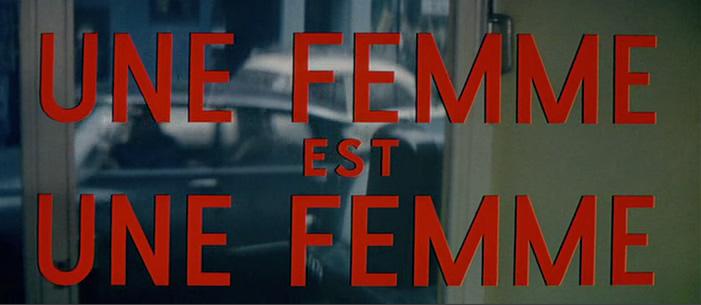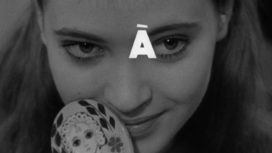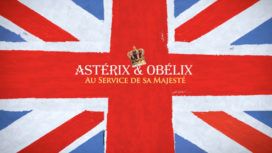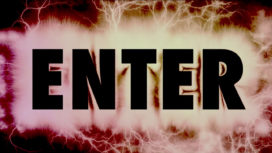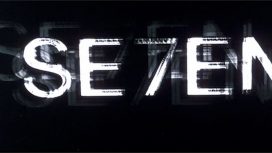GODARD’S TYPOGRAPHIC WORD-PLAY
Jean-Luc Godard’s oeuvre, especially the classic films of the 1960s, remains the benchmark against which all typographic film-making must be measured.
Rick Poynor, Eye Magazine
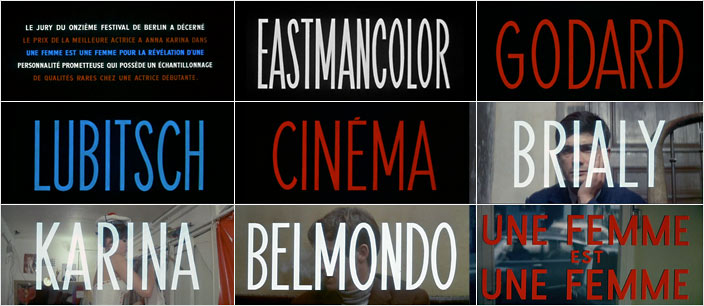
In part 2 of French Fridays, a new series on Watch the Titles dedicated to French title design ’50’s – ’80’s, French designer Laure Chapalain takes a closer look at Godard‘s short typographic main title for Une Femme Est Une Femme (A Woman Is A Woman) – a musical comedy that is widely regarded as Godard’s most accessible film. In these unorthodox and playful titles, Godard mixes the credits with words that prefigure the movie’s spirit.
Subscribe to Watch the Titles updates by email.
Une Femme Est Une Femme is Jean-Luc Godard’s third feature film. It tells the story of a love triangle between Angela (Anna Karina), Emile (Jean-Claude Brialy) and Alfred (Jean-Paul Belmondo). Angela is a stripper and Emile’s girlfriend. She wants to have a baby with him right now but Emile doesn’t want to, so she throws herself into Alfred’s arms to make him jealous. Alfred, who is in love with her, agrees to get her pregnant.
Godard created his own titles. He had a very particular and personal approach to this medium of expression, which he used to claim his own vision of cinema. The short title sequence, plays with the meaning of words in a wonderful, inventive and simple way, leading the audience to ponder not only Godard’s cinematic vision – but also his essence as a creator.
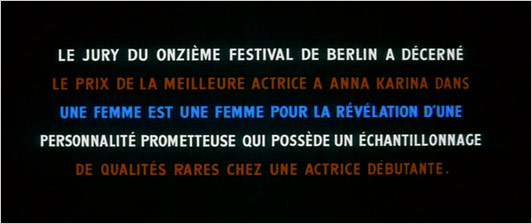
The jury of the eleventh festival of Berlin has awarded the special nr 1 prize to A Woman Is A Woman for the originality, youth, audacity, and impertinence of a film that shakes up the conventions of the classic movie comedy.
We hear musicians tuning their instruments while the famous composer Michel Legrand, who would go on to create music for Les Demoiselles de Rochefort (The Young Girls of Rochefort) and The Thomas Crown Affair, asks them to get ready, evoking the feeling of a concert that is about to start – a clear indication by Godard that we are about to witness a performance.
Beautiful, bold typography in white, red and blue appears on the screen. Godard would go on to use this typographic style for several future titles. These three colors are the dominant colors throughout the movie. He uses only capital letters, as if the titles were made of the neon lights of a theater.
In this title sequence, Godard shows us a kind of exquisite corpse, implying the analytic involvement of the audience. Indeed, he mixes the names of the people who have participated in the movie’s creation (as traditional titles do) with words which prefigure the movie’s spirit : “Once upon a time”, “French comedy”, “Musical”, “Melodramatic”, “Sentimental”, “Opera”, finishing with “Cinema”. We are at liberty, as the audience, to make connections between pictures and words. According to Godard, the reinvention of cinema is, “to show at the same time as to demonstrate, to innovate at the same time as to copy, to criticize at the same time as to create”.
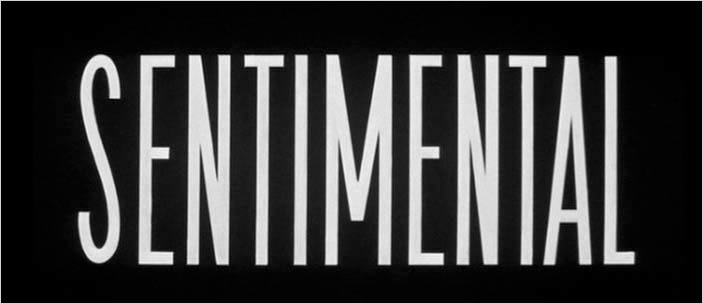
Godard‘s titles include the name Lubitsch, referring to Ernst Lubitsch – the German-American director he admires. It’s also a proclamation of his love for American comedies from the 1940’s and the 1950’s. To emphasize this tribute, he names one of the main characters, performed by Belmondo, Alfred Lubitsch. By writing it in the titles, Godard plays with the confusion between what is real (cast and crew) and what is fiction. The film director is about to show us a movie about the true nature of a story.
After the word “Cinema”, each protagonist is introduced with Anna Karina’s voice pronouncing “Light!”, “Camera!”, “Action!”. Once again Godard plays with us with the word “camera,” which sounds a lot like “Karina”, as if the main actress is introducing herself. We read what we are hearing. The title perfectly precludes the movie it is made for: a stylized composition and a playful exercise of rhythm and colors.
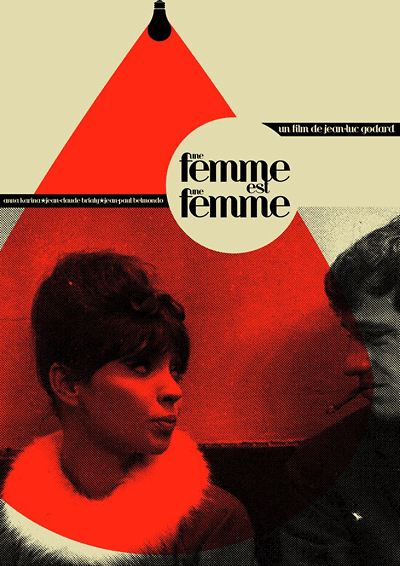
Text: Laure Chapalain, © SubmarineChannel 2011
Year of production
1961
About Jean Luc Godard
Jean-Luc Godard began his career in cinema as a journalist for the renowned review rag “Les Cahiers du Cinéma”, along with a smattering of his contemporary soon-to-be French cinema superstars like Truffaut, Chabrol, Rivette or Rohmer. These young talents were influenced by foward-thinking Hollywood directors, and they distinguished “authors” from ordinary filmmakers or film technicians, unlike mainstream critics and audiences at that time.
Full credits
Director and title designer
Jean-Luc Godard
Composer
Michel Legrand

